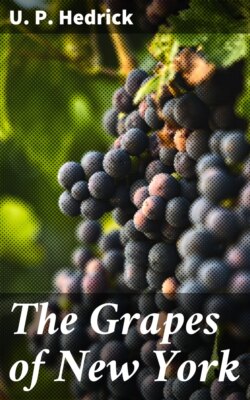Читать книгу The Grapes of New York - U. P. Hedrick - Страница 24
На сайте Литреса книга снята с продажи.
4. VITIS MONTICOLA Buckley.[133]
ОглавлениеTable of Contents
1. Buckley, Proc. Phil. Acad. Nat. Sci., 1861:450. 2. Ib., U. S. Pat. Off. Rpt., 1861:485. White grape; Mountain grape. 3. Engelmann, Bush. Cat., 1883:10, 12, 14, 15, 16. Mountain grape of West Texas. 4. Munson, Am. Hort. Soc. Rpt., 1885:134. Mountain grape. 5. Ib., Soc. Prom. Ag. Sci. Rpt., 1887:59. Mountain grape. 6. Ib., U. S. D. A. Pom. Bul., 3:13. 1890. V. Texana. 7. Ib., Gar. and For., 3:474, 475. 1890. 8. Ib., Am. Gard., 12:586. 1891. Sweet Mountain grape. 9. Ib., Mich. Hort. Soc. Rpt., 1893:116. 10. Bailey, Gray’s Syn. Fl., 1:422. 1897. Sweet Mountain grape. 11. Munson, Tex. Sta. Bul., 56:230, 232, 234, 239, 260. 1900. Sweet Mountain grape. 12. Viala and Ravaz, Am. Vines, 1903:42, 96.
Vine of moderate vigor, climbing, or, in the absence of support, frequently shrubby. Canes very slender; shoots angled, more or less pubescent; diaphragms medium to rather thin; tendrils medium in size, intermittent, usually bifid, deciduous. Leaves with stipules short, broad; leaf-blade small and thin, cordate, entire, notched or shortly three-lobed; petiolar sinus rather deep and medium to narrow in width, sometimes overlapping, rounded; margin broadly and obtusely toothed; apex usually acuminate; upper surface smooth, glossy; lower surface grayish-green, more or less pubescent when young; pubescence confined chiefly to ribs and veins. Clusters short and broad, compact, with medium to short peduncle. Berries medium to below in size, black or gray with thin bloom. Seeds large, usually slightly notched; chalaza rather narrow; raphe a groove. Leafing, flowering, and ripening fruit very late.
Vitis monticola was named and described by Buckley in 1861. There seems to have been some misunderstanding by later botanists as to exactly what Buckley’s species of this name is, and in spite of what has been written on the subject, it seems as though some of the botanists are still describing different species. The seed, in Engelmann’s figure, resembles that of the Rupestris very closely, while as figured by Viala the seeds resemble those of Cinerea or Cordifolia.
Monticola inhabits the limestone hills of central and southwestern Texas.
The fruit of this species has a very sweet and somewhat peculiar flavor. The vines can be propagated from cuttings only with difficulty. The species is adapted to a hot, dry climate and limestone land. It is found to be very resistant to phylloxera and is sometimes recommended as a stock for Vinifera but is not generally considered as valuable in this respect as Berlandieri. It is without value for its fruit and is of no horticultural importance to the eastern American grape-grower.
